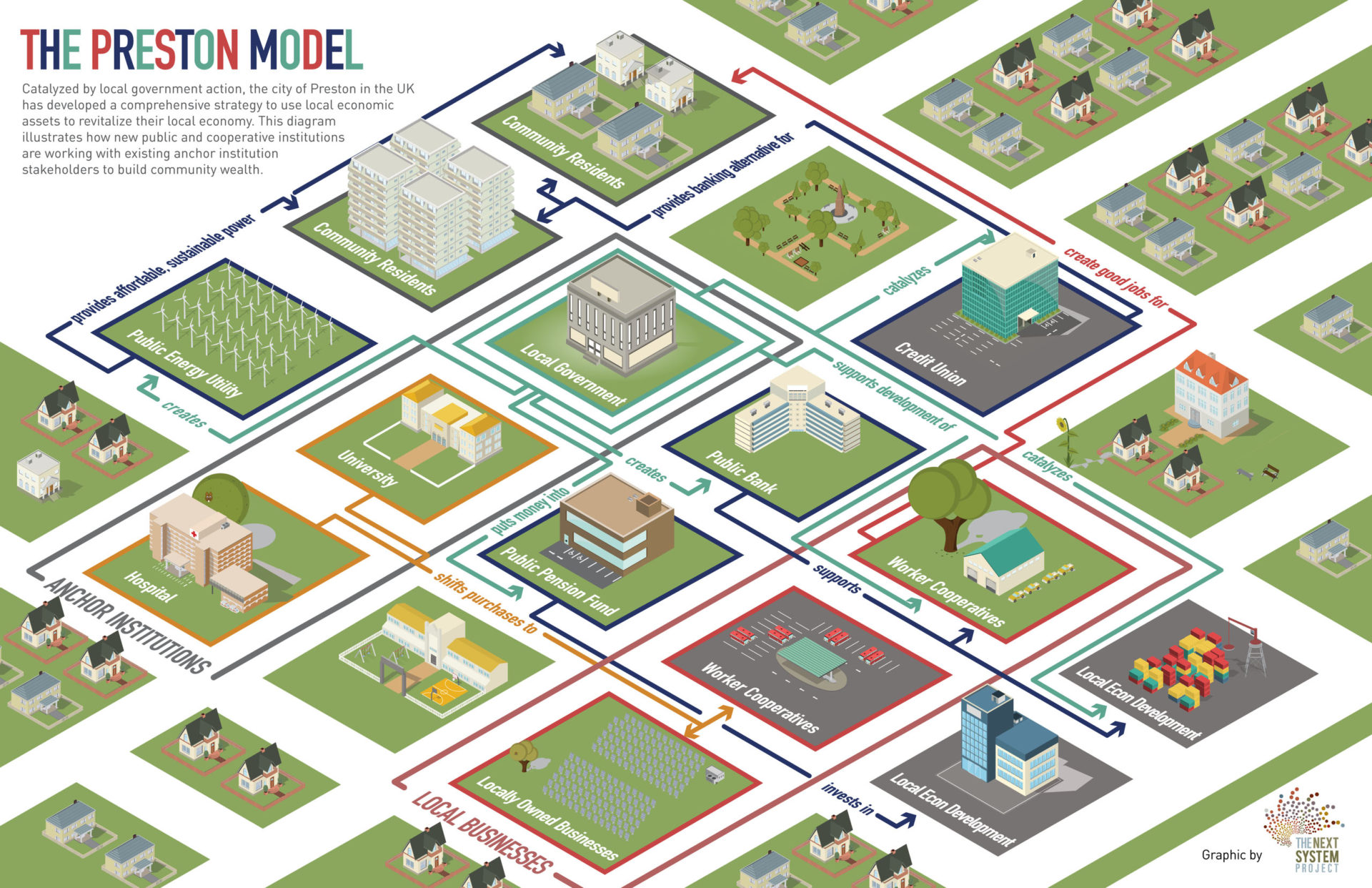After the global financial crisis hit the UK in the late 2000s, local government budgets were among the first to be hit by austerity measures. Since then, many have seen these budgets halved. Poor social care provision, inadequate waste collection, under-maintenance of public space, social housing sell-offs, rising homelessness and a whole bunch of other very visible marks of austerity have all naturally fuelled a growing search for ways out of the vicious cycle of disinvestment that government cuts have brought about.
It is in this context that there has been a growing enthusiasm for the concept of “community wealth building”. Community wealth building encompasses a series of urban governance practices, usually initiated by municipal government in collaboration with local charitable and activist networks, which seek both to prevent value from being extracted from a community as private profit and to increase the overall wealth of the community over time. One of the chief mechanisms by which it does this is by encouraging so-called anchor institutions — hospitals, universities, schools, and other big employers that cannot leave the town — to spend more of their money locally, employing local contractors rather than outsourcing to large multinational companies.
This is well explained by Marjorie Kelly, one of the leading proponents of community wealth building in the US: “…building community wealth is about developing underutilized local assets of many kinds — social networks, the built environment, cultural riches, local ecology, anchor institutions — and doing so in a way that the wealth stays local and is broadly shared”.
There is much to be praised about this growing movement against the extractive economic practices which have so defined the era of neoliberal globalisation. But the movement’s heavy emphasis on the term “community” deserves unpacking. Is it compatible with the prevailing transience of contemporary urban life? Does it rely too heavily on an idealised notion of community? And how much does this localised urbanism function as a cover up for the lack of redistribution at the national or even global scale?
Amid ever tighter controls on local government spending, prevailing orthodoxy in the UK has, at least until recently, emphasised cutting non-essential services and offering up contracts to large outsourcing companies like Capita, Serco and Carillion. These companies, so the orthodoxy goes, would be able to make cost savings through their superior management techniques, unsentimental cutting of waste and economies of scale — although more often than not any money saved is in the form of erosion of workers’ pay and conditions, tax breaks, tax avoidance and a general reduction in the level and quality of service.
This approach is best captured in the policies of Barnet council in North London. When post-crisis austerity hit, the council planned to cut direct employees by 90%, from over 3000 to as little as 332. Dubbed “easyCouncil” for its maniacal pursuit of outsourcing, Barnet gave contracts totalling almost half a billion pounds to the large outsourcing company Capita. Given the collapse, earlier this year, of Carillion, this huge reliance on the services of a single company has left the council extremely exposed (indeed Barnet Council have been forced to draw up contingency plans for just such an event).
Preston stands in stark contrast to Barnet. Here, under the leadership of council leader Matthew Brown, the Northern English city has embarked upon a hugely impactful process of community wealth building, mainly by encouraging a series of aforementioned anchor institutions to spend money locally. In 2013, six local public bodies spent £38m in Preston and £292m in all of Lancashire. By 2017 these figures had increased to £111m and £486m respectively, despite an overall reduction in the council’s budget. Meanwhile, the council has set up a credit union to compete with payday loan companies, helped to set up worker cooperatives to provide goods and services to public bodies and, in 2012, became the first living wage employer in the North of England.
The extent to which Preston’s approach has broken with the prevailing philosophy of municipal governance in the UK is well summed up in an article by Aditya Chakraborty, written for his “Alternatives” series in the Guardian (which is well worth reading in full): “Small cities trailing big histories rank among the flotsam of 21st-century capitalism. With a big enough dowry (some subsidies, perhaps, or free roads and cheap labour), they might catch the eye of a passing multinational bearing some dubious inward investment. A distribution warehouse, say, with poverty-pay jobs, or a high-street killer of a retail park.” This was the situation in Preston following the crisis. “But”, says Chakraborty, “the city council no longer plays that game”.
Preston’s council and its wider community more than deserves the praise it has received. Through its adoption of community wealth building practices, the municipality has made an awful situation at the national scale much less awful at the local scale. But obviously this also serves to underline the dire situation prevailing nationally, where, in a form of “territorial injustice” cuts to government spending have disproportionately affected areas of the UK in which public services are in greater demand and where they are a major employer, while wealthier parts have remained much less affected. Furthermore, it is telling that community wealth building efforts have occurred in the two countries which have seen the most drastic transition from social democratic to neoliberal economic models and where the welfare state has most rapidly retracted, the US and the UK.
Questions also remain as to how such community wealth building practices apply in a modern world characterised more than ever by transience, where it is difficult to sustain traditional notions of community, centred on a specific geographical place which people can commit to over a long period of time. How does someone retain wealth when they’re in and out of the local area intermittently? Or do they not have as much of a claim to such wealth as anyone else? What do we mean by community anyway? Is it something that requires a deep and long-term attachment to a place? And should we have to engage with a community in order to enjoy the benefits of, for instance, decent and well-funded adult social care? Or, rather, do we simply have the right to receive that care from a supportive state anywhere we end up?
A tentative answer to these questions can be found in Doreen Massey’s notion of the “global sense of place”, surely one of the most compelling attempts to articulate a modern, outward-looking conception of community and place. Massey describes the notion in her essay “Geographies of Responsibility” as follows:
If one moves in from the satellite towards the globe, holding all those networks of social relations and movements and communications in one’s head, then each ‘place’ can be seen as a particular, unique, point of their intersection. It is, indeed, a meeting place. Instead then, of thinking of places as areas with boundaries around, they can be imagined as articulated moments in networks of social relations and understandings, but where a large proportion of those relations, experiences and understandings are constructed on a far larger scale than what we happen to define for that moment as the place itself, whether that be a street, or a region or even a continent. And this in turn allows a sense of place which is extroverted, which includes a consciousness of its links with the wider world, which integrates in a positive way the global and the local.
Massey’s “global sense of place” acknowledges that all claims to community are shaky, since every place is formed far beyond the local scale. This doesn’t mean we give up trying to protect the value that is being produced in these moments from being extracted as private profit. But retaining it as community wealth does become rather complicated in light of Massey’s concept, when you consider that any “community” is necessarily boundless, embracing newcomers, short-stayers and anyone who might pass through at a given moment.
To retain wealth in this kind of community would require a system which both recognises the value that someone generates at these momentary meeting points and channels it into a global commonwealth that everyone has access to when they need it. Such a system would facilitate a community that is completely open and welcoming to both new arrivals and temporary residents, since their presence would still be registered as a contribution to the community’s wealth. The problem is, what I’m describing is communism, which is a much harder sell and one which community wealth builders have avoided for obvious reasons (especially, again, considering the countries they operate in). In seeking to transfer control over the means of producing value from landowners to value producers and doing so not locally but universally, this proposal is much more radical.
Such radicalism is only implied in the message of community wealth building, which is more inclined to appeal to common sense notions of economic fairness and the traditional Keynesian desire to have wealth circulating in the (local) economy. While completely reasonable in itself, this message fails to grasp the underlying implications of community wealth building if it were to spread beyond the local scale. And yet, for the idea to avoid lapsing into a kind of conservative local protectionism and embrace the transient nature of modern life, this is exactly what needs to happen.


